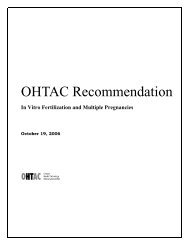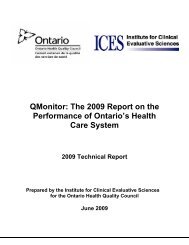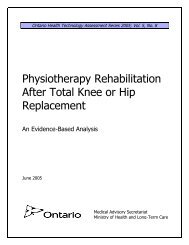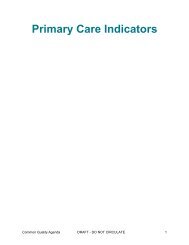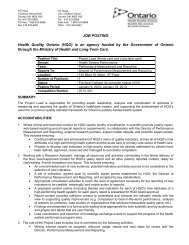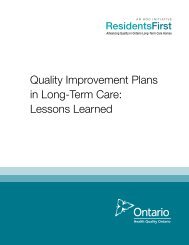Measurement for Quality Improvement - Health Quality Ontario
Measurement for Quality Improvement - Health Quality Ontario
Measurement for Quality Improvement - Health Quality Ontario
Create successful ePaper yourself
Turn your PDF publications into a flip-book with our unique Google optimized e-Paper software.
PLAN-DO-STUDY-ACT (PDSA)<br />
Step 1<br />
Step 2<br />
Step 3<br />
Step 4<br />
PLAN (who, what, where, when, and why)<br />
• State the purpose of the PDSA—are you developing a<br />
change idea, testing a change, or implementing a change?<br />
• What is your change idea?<br />
• What indicator(s) of success will you measure?<br />
• How will data on these indicators be collected?<br />
• Who or what are the subjects of the test?<br />
• How many subjects will be included in the test and over<br />
what time period?<br />
• What are your predictions as to what will happen?<br />
DO<br />
• Conduct the test.<br />
• Document the results, measurements, challenges and<br />
unintended consequences.<br />
STUDY<br />
• Analyze the data and study the results.<br />
• Compare the data to your predictions.<br />
• Summarize and reflect on what was learned.<br />
ACT<br />
• Refine the change idea based on lessons learned from the<br />
test.<br />
• Prepare a plan <strong>for</strong> the next test. Dependent on results the<br />
idea should be adopted, adapted or abandoned.<br />
LEADING AND LAGGING INDICATORS:<br />
“Leading” and lagging” indicators offer more ways of gaining knowledge<br />
about how a system is per<strong>for</strong>ming and where to focus your quality<br />
improvement ef<strong>for</strong>ts.<br />
A leading indicator provides in<strong>for</strong>mation about how a process is per<strong>for</strong>ming<br />
after changes have been implemented. A lagging indicator is one that<br />
provides in<strong>for</strong>mation about how the system is per<strong>for</strong>ming after changes have<br />
been made. In quality improvement, process measures are usually referred<br />
to as “leading,” while outcome measures are referred to as “lagging”. If<br />
the per<strong>for</strong>mance of a process measure begins to drop, it is likely that the<br />
per<strong>for</strong>mance of an outcome measure will also decline. 3<br />
For example, assessment of residents in long-term care <strong>for</strong> falls (process) will<br />
typically serve to prevent falls (outcome), as actions are taken in response to<br />
what is learned in the assessment. If the quality improvement team focused<br />
on the level of completion of these assessments over time and discovered<br />
that the rate of completion declined, it would be a fairly good predictor<br />
<strong>Measurement</strong> <strong>for</strong> <strong>Quality</strong> Improvment| <strong>Health</strong> <strong>Quality</strong> <strong>Ontario</strong> 7




